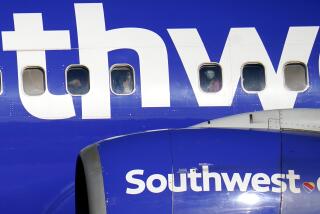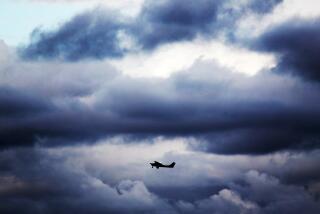Aircraft Smoking Ban Will Cut Air Pollution : Airlines: Passengers will be able to breathe a little easier thanks to a new law that goes into effect today banning smoking on U.S. flights of less than six hours.
- Share via
If you’re an airline passenger who smokes, you’ve probably already begun to panic. The deadline approached, the clock ticked away and now you are confronted with the awful truth.
As of today, Feb. 25, a federal law is in effect that prohibits smoking on all airlines flying between any two airports in the United States if the flight lasts six hours or less.
The old rule that banned smoking on all flights lasting two hours or less is history. The U.S. smoking ban is systemwide and applies to all airlines, foreign and domestic.
The new law prohibits smoking on passenger airline flights of six hours or less in the U.S. The rule does not apply to international flights that arrive in or depart from U.S. cities.
For example, you cannot smoke on a Pan Am flight from Los Angeles to New York. If that flight continues to Paris, smoking is allowed on the overseas leg.
Some air carriers didn’t wait for the law to take effect today. Pan Am began the ban Feb. 5. Northwest Airlines beat everyone when it made all its domestic flights nonsmoking in April, 1988.
Some U.S. flights still are exempt from the rule. Airlines that fly between Chicago, Dallas, Minneapolis and Las Vegas and Honolulu could allow smoking on such flights, because they exceed six hours.
American says it will permit smoking on its Dallas and Chicago flights to Honolulu. TWA will also allow smoking on its St. Louis-Hawaii runs. American, Pan Am and United are generally allowing smoking on flights to the Caribbean, Mexico and Canada; most of these flights last under six hours, but they are to foreign destinations.
But there are some carriers that are even going beyond the new rule in extending the nonsmoking ban.
Delta will not allow smoking on any of its flights in North America and the Caribbean. That effectively rules out smoking on all Delta flights to destinations in Hawaii, Alaska, Puerto Rico, the Bahamas, Bermuda, Canada and Mexico.
Northwest won’t allow smokers to light up on its Minneapolis-to-Hawaii flights.
Although it is not required to do so, Virgin Atlantic Airways, which flies between New York, Newark and Miami to London, announced that it will become the first airline to offer an all nonsmoking service on service between New York and London.
Starting May 18, the airline will introduce a second 747 on the Newark-Gatwick route and the plane will be designated nonsmoking.
“We’ve been noticing a steady increase in passenger comments about cigarette smoking on board our aircraft,” said Richard Branson, Virgin’s chairman. “We wanted to make a firm stand by offering a choice of smoking or nonsmoking departures.”
If the Newark nonsmoking service proves successful, Virgin will add nonsmoking London flights to and from New York’s Kennedy airport, Miami, and, later this year, Los Angeles.
The Canadian government has gone a step further. Effective July 1, smoking will be banned on all Canadian registered commercial passenger aircraft--worldwide.
What will be the impact of the new nonsmoking regulations?
First, if you’re a frequent flyer, the smoking ban may open more window and aisle seats previously allocated to smokers.
The smoking ban also will allow some more domestic airlines to introduce business class. Only TWA offers systemwide business class compartments on its wide-body aircraft.
But perhaps most important will be the short- and long-term health impact of the smoking ban on airline passengers.
Flight crews also will benefit. In March, 1988, a study commissioned by the Aviation Safety Institute, a nonprofit industry watchdog group, determined that cigarette smoke reduces the blood oxygen levels of pilots and flight attendants and could adversely affect their judgment.
One hope is that with smoke no longer circulating through airplane cabins, fewer of us will emerge from our flights with sore eyes, sore throats and colds.
But therein lies a continuing problem of airline ventilation. Smoke is only one irritant drifting around airline cabins. It is often joined by high levels of carbon monoxide, carbon dioxide and ozone.
Indeed, flying inside an airline cabin for long periods is tantamount to being stuck inside an aluminum petri dish. An inordinately high concentration of bacteria, fungi and viruses are often detected in airline cabins.
The reason: poor ventilation, poor cleaning and maintenance of air conditioning systems and filters and less-than-full use of those systems by airlines during flight.
In an ideal situation fresh air is drawn into the airplane via engine intakes, filtered and regulated to the correct temperature, then pumped into the cabin.
But more often than not, many airlines don’t want to use the energy to do that. Instead, these airlines recycle the air. When airlines don’t clean their air filters properly and regularly the problem of poor quality cabin air is compounded.
A Boeing 747 has three “airpacs”--air-conditioning and ventilation systems. But how many airlines use all three in flight? Very few.
The smoking ban is a good start toward cleaner cabin air but it is only a first step.
The next time you fly, ask a flight attendant if all the airpacs are being used. If not, complain. Then we’ll all be able to breathe a little easier.
More to Read
Sign up for The Wild
We’ll help you find the best places to hike, bike and run, as well as the perfect silent spots for meditation and yoga.
You may occasionally receive promotional content from the Los Angeles Times.






